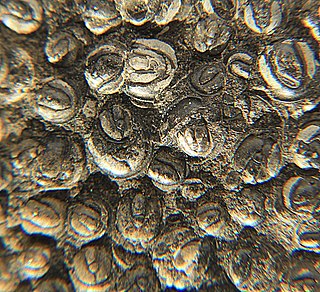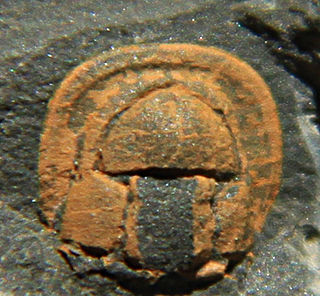
Agnostus is a genus of agnostid trilobites, belonging to the family Agnostidae, that lived during the late Middle Cambrian – early Upper Cambrian. It is the type genus of the family Agnostidae and is subdivided into two subgenera, Agnostus and Homagnostus.

Agraulos is a genus of Solenopleuridae trilobites that lived during the Middle Cambrian in North America and Europe, particularly the Czech Republic. The genus was named by Hawle & Corda in 1847.
Elliptocephala is an extinct genus from a well-known class of fossil marine arthropods, the trilobites. It lived from the later part of the Tommotian to the upper Botomian. Elliptocephala can easily be confused with Ellipsocephalus, a trilobite genus of the Ptychopariida order.

Xystridura Whitehouse, 1936 is a genus of Redlichiid trilobite described originally from the Middle Cambrian (Miaolingian) strata of Queensland, Australia. The genus ranges upwards from Ordian into Florian Stages in terms of Australian Cambrian stratigraphic nomenclature.

Peronopsis is a genus of trilobite restricted to the Middle Cambrian. Its remains have been found in Asia, Australia, Europe, and North America.

The Wheeler Shale is a Cambrian (c. 507 Ma) fossil locality world-famous for prolific agnostid and Elrathia kingii trilobite remains and represents a Konzentrat-Lagerstätte. Varied soft bodied organisms are locally preserved, a fauna and preservation style normally associated with the more famous Burgess Shale. As such, the Wheeler Shale also represents a Konservat-Lagerstätten.
Trilobites are used as index fossils to subdivide the Cambrian period. Assemblages of trilobites define trilobite zones. The Olenellus-zone has traditionally marked the top of the Lower Cambrian, and is followed by the Eokochaspis zone.

Ptychagnostus is a member of the agnostida that lived during the Cambrian period. Ptychagnostidae generally do not exceed one centimetre in length. Their remains are rarely found in empty tubes of the polychaete worm Selkirkia. The genus probably ranged throughout the water column. It has two glabellar lobes, and three pygidial lobes.

The Marjum Formation is a Cambrian geological formation that overlies the Wheeler Shale in the House Range, Utah. It is named after its type locality, Marjum Pass, and was defined in 1908. The formation is known for its occasional preservation of soft-bodied tissue, and is slightly younger than the Burgess Shale, falling in the Ptychagnostus praecurrens trilobite zone.

Skeemella is a genus of elongate animals from what is now the Middle Cambrian Wheeler Shale and Marjum lagerstätte of Utah. It has been classified with the vetulicolians.
The Drumian is a stage of the Miaolingian Series of the Cambrian. It succeeds the Wuliuan and precedes the Guzhangian. The base is defined as the first appearance of the trilobite Ptychagnostus atavus around 504.5 million years ago. The top is defined as the first appearance of another trilobite Lejopyge laevigata around 500.5 million years ago.
The Wuliuan stage is the fifth stage of the Cambrian, and the first stage of the Miaolingian Series of the Cambrian. It was formally defined by the International Commission on Stratigraphy in 2018. Its base is defined by the first appearance of the trilobite species Oryctocephalus indicus; it ends with the beginning of the Drumian Stage, marked by the first appearance of the trilobite Ptychagnostus atavus around 504.5 million years ago.

The Peronopsidae comprise the earliest family of the Agnostina suborder. Species of this family occurred on all paleocontinents. The earliest representatives of this family first occur just before the start of the Middle Cambrian, and the last disappeared just after the start of the Upper Cambrian.

Pleuroctenium Hawle & Corda (1847) is an agnostid trilobite belonging to the family Condylopygidae Raymond (1913). The genus occurs in Middle Cambrian (Drumian) strata of Canada, the Czech Republic, England and Wales, France, and Sweden.
Diplorrhina Hawle and Corda (1847) is a genus of trilobite belonging to Order Agnostida. It lived during the early Middle Cambrian in what are now the Czech Republic and the North Siberian plateau. as in members of the family Peronopsidae it lacks a preglabellar furrow. Both cephalon and pygidium lack spines. It is difficult to distinguish Diplorrhina from many other peronopsids.

Condylopyge Hawle and Corda (1847) is a genus of agnostid trilobite that lived during the late Lower and early Middle Cambrian, in what are today Canada, the Czech Republic, England and Wales, France, Germany, Italy, Morocco, the Russian Federation, Spain, Turkey and Sweden. It can easily be distinguished from all other Agnostida because the frontal glabellar lobe is notably wider than the rear lobe. It belongs to the same family as Pleuroctenium but the frontal glabellar lobe does not fold around the rear lobe, as it does in that genus. Condylopyge is long ranging, possibly spanning the early Cambrian Terreneuvian Series in Nuneaton, central England into at least Drumian strata at various locations elsewhere.
Ovatoryctocara is a genus of small corynexochid trilobites from the Cambrian, that lived in what now are Siberia, China, Greenland and Canada (Newfoundland). Ovatoryctocara can be recognised by the combination of the following characters: the central raised area of the cephalon is approximately cylindrical and has two rows of four triangular or round pits. The thorax only has 5 or 6 segments. The tailshield has an axis of 6 to 12 rings, the pleural furrows are well developed and the border is absent or narrow as a hair.
Schmalenseeia is genus of trilobites of uncertain affinity, that lived during the middle Middle to earliest Upper Cambrian. Species assigned to Schmalenseeia have been found in Norway, Sweden, Northern Siberia, Eastern China, Australia (Tasmania), India (Himalayas) and the United Kingdom.

Genevievella is a genus of trilobites with a short inverted egg-shaped outline, a wide headshield, small eyes, and long genal spines. The backrim of the headshield is inflated and overhangs the first of the 9 thorax segments. The 8th thorax segment from the front bears a backward directed spine that reaches beyond the back end of the exoskeleton. It has an almost oval tailshield with 5 pairs of pleural furrows. It lived during the Upper Cambrian in what are today Canada and the United States.

Bailiaspis Resser, 1936, is a Middle Cambrian (Miaolingian) trilobite genus belonging to the Family Conocoryphidae Angelin, 1854. Within the Acado-Baltic region, the genus ranges from Wuliuan into Guzhangian age strata.
![Itagnostus interstrictus - Wheeler Schale, Utah, USA - Cambrian period ([?] -507 MA) - 39.25degN 113.33degW .jpg](http://upload.wikimedia.org/wikipedia/commons/thumb/6/6b/Itagnostus_interstrictus_-_Wheeler_Shale%2C_Utah%2C_USA_-_Cambrian_period_%28%E2%89%88_-507_MA%29_-_39.25%C2%B0N_113.33%C2%B0W.jpg/220px-Itagnostus_interstrictus_-_Wheeler_Shale%2C_Utah%2C_USA_-_Cambrian_period_%28%E2%89%88_-507_MA%29_-_39.25%C2%B0N_113.33%C2%B0W.jpg)












